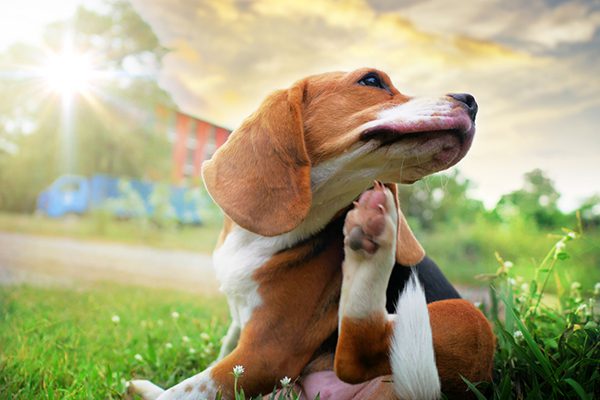Tips to Treating Your Dog’s Seasonal Allergies in Clifton Park, NY
Spring and summer may be seasons that many people look forward to following a long, cold winter. With warmer temperatures and longer days, it is the perfect time to get outdoors and spend some time with your canine companion.

However, seasonal allergies can make it miserable. Along with common symptoms like a runny nose or coughing, it can also give you an overall uncomfortable feeling. The same is true for dogs.
Though the symptoms may look different, your dogs can suffer from seasonal allergies and allergy attacks as well. While they cannot tell you what is wrong with them there are clear signs that you can be on the lookout for that may point to a problem with allergies in your dog.
Common Allergens for Dogs
Let’s get to the basics. What are allergies? Allergic reactions happen when the body has sensitivities to a specific substance. In most cases, the immune system can fight off diseases and infections. But when it comes to allergies, the body reacts negatively in an attempt to get rid of what is causing the reaction.
One of the main differences between the way human bodies and dog bodies react to allergens is the way they are set off. While humans are more likely to breathe in an allergen, a dog’s allergies are typically triggered when an allergen is taken in through their skin or paws.
Many of the things that cause allergies in humans can also cause harm to our pets. The list of common allergens includes:
- Pollen
- Mold
- Weeds
- Grass
- Fungus
- Fleas
Allergies in dogs is not uncommon. In fact, about 10 percent of dogs suffer from allergy issues. But some breeds are more prone to being susceptible than others. Some of those breeds include:
- Bulldogs
- Pugs
- Terriers
- Setters
- Retrievers
This can be important information to keep in mind whether you are searching for a new dog, or your current dog is exhibiting symptoms that could be associated with seasonal allergies.
What Do Seasonal Allergies Look Like in Dogs?
Every dog is different, and as you might as expect their reaction to coming into contact with allergens varies.
However, there are some common signs and symptoms that you can look for that can help you give your pet relief.
Itchy/Inflamed Skin
When it comes to seasonal allergies in dogs, itchy or inflamed skin is one of the first signs that your dog is suffering. This all goes back to the fact that dogs are more likely to absorb allergens through the skin and paws. An allergic reaction could make your pet’s skin appear red, swollen, or moist.
Increased Scratching/Biting
Of course, if your pet’s skin is bothering them because of an allergic reaction, they are going to try to find relief. You may notice your dog scratching or biting a particular part of their body.
This can lead to a condition called atopic dermatitis. This causes severe itching, similar to the sensation a human with chicken pox might feel.
Licking Their Paws
Like with the skin, when dogs absorb an allergen through their paws they may focus on relieving that itch. You may notice them seemingly uncontrollably licking their paws.
This happens because your dog’s body tries to push whatever is causing problems to the extremities.
Scooting or Licking the Backside
The histamines that trigger a response to allergens will sometimes cause irritation in your dog’s backside. Similar to when a dog licks its paws to relieve irritation, they may do the same with their behind. You may also notice red, irritated skin or hair falling out, as well.
Balding/Shedding
As you see, a lot of allergy symptoms often appear in the skin. If you notice excessive shedding, or patches of hair missing, it could be a sign that your dog is suffering from an allergy issue.
The shedding can be intensified by your dog’s scratching and/or licking. Dandruff can also be a problem, so you may also see some flaking.
Ear Infections
Some dogs are also prone to ear infections as a result of seasonal allergies, especially if they have floppy ears. Obvious signs of an ear infection include a swollen or red ear canal, crust or scabs in or around the ears, dark or bloody discharge, a bad smell and loss of balance.
You may also see your dog shaking its head more. Ear infections are not only painful for your dog, but can lead to more serious issues, even hearing loss.
Respiratory Infections
While it is a more common symptom in humans, cough, wheezing, sneezing and difficulty breathing can all point to an issue with the respiratory system. If you believe your dog is having trouble breathing or has any other signs of problems with the respiratory system, contact your veterinarian as soon as possible.
Managing Your Dog’s Seasonal Allergies in Clifton Park
No one wants their pet to suffer. So, the question becomes: How do I manage my dog’s seasonal allergies? While there is no cure for these allergies, there are several things you, along with your veterinarian, can do to alleviate some of the symptoms.
The best way to treat allergies in dogs is to eliminate the allergen that your dog has come into contact with. If that is not possible, then making some changes to your routine may also help.
- Change Your Walking Time: Allergens, especially pollen, is worst early in the morning or late in the afternoon. If this normally when you take your dog for a walk, you might want to consider changing the time to avoid pollen at its peak.
- Change Your Walking Route: If your daily walks with your dog take you by large fields or through parks, you might want to consider changing your route. By avoiding the places where many allergens are found, you can reduce the allergy attacks for your dog.
- Thoroughly Clean Your Dog: Ensuring that allergens are removed from your dog’s skin, fur and paws is also important for avoiding allergies. There is no need for a full bath, but wiping your dog down with a pet-safe wipe can make a huge difference.
- Keep Your Home Clean: If your dog spends a lot of time indoors, make sure their environment is safe and clean. Remove dust and mold from the air and on surfaces, to cut down on allergy symptoms.
- Medicated Shampoos/Topical Medicines: If your dog’s allergies are severe enough to require a visit to the vet, they may prescribe medicated shampoos or lotions that can reduce irritation and sooth your dog’s skin.
Unfortunately, allergies cannot always be avoided. If you are having trouble keeping your dog’s allergies under control, talk to your veterinarian about what solutions they can offer to you.
Recent Posts
Pet First Aid: Essential Supplies for Your Pet Emergency Kit
Pet First Aid: Essential Supplies for Your Pet Emergency Kit Every pet parent wants to keep their…
Benefits of Spaying or Neutering a Cat
Benefits of Spaying or Neutering a Cat Deciding to spay or neuter your cat is a responsible…
Why Does My Cat Get Eye Boogers Everyday?
Why Does My Cat Get Eye Boogers Everyday? Cats are known for their meticulous grooming habits, but…
About Us
Originally opened as Animal Care Hospital by Dr. Mark Johnston in 1989, the hospital became Cornerstone Veterinary Hospital in 2015 when it was purchased by Drs. Alan and Lisa Knott. The name 'Cornerstone' holds a special place in their hearts, representing not only their Christian faith but also their commitment to being the cornerstone of the community in which they practice. As a family-owned and operated practice, every pet is treated as part of the family, ensuring they receive the highest standard of care. The team at Cornerstone Veterinary Hospital is dedicated to building lasting relationships with clients and their beloved pets, striving to be the cornerstone of the community in which they practice.



